We’ve created a series of unique business plan templates, outlined below, that you can download and customize for any business.
Writing a business plan is the first step to establishing a foundation for your business. While many entrepreneurs write their plans to inform and appeal to investors, a business plan is a useful asset to have regardless of how you secure funding. Creating a comprehensive plan ensures you're entering a growing market and have the blueprint for doing so.
Some things to consider in your plan include your legal structure, accounting, marketing, and exit strategy. When writing the fine print, you don’t have to reinvent the wheel, as you can follow templates.
Why should you write a business plan?
Writing a thorough and detailed business plan before jumping into your business endeavor helps you establish a blueprint for your company. It allows you to plan for different financial scenarios, organize your management team, and craft a cohesive brand strategy. Below, we’ve listed a few of the many benefits of writing a detailed business plan.
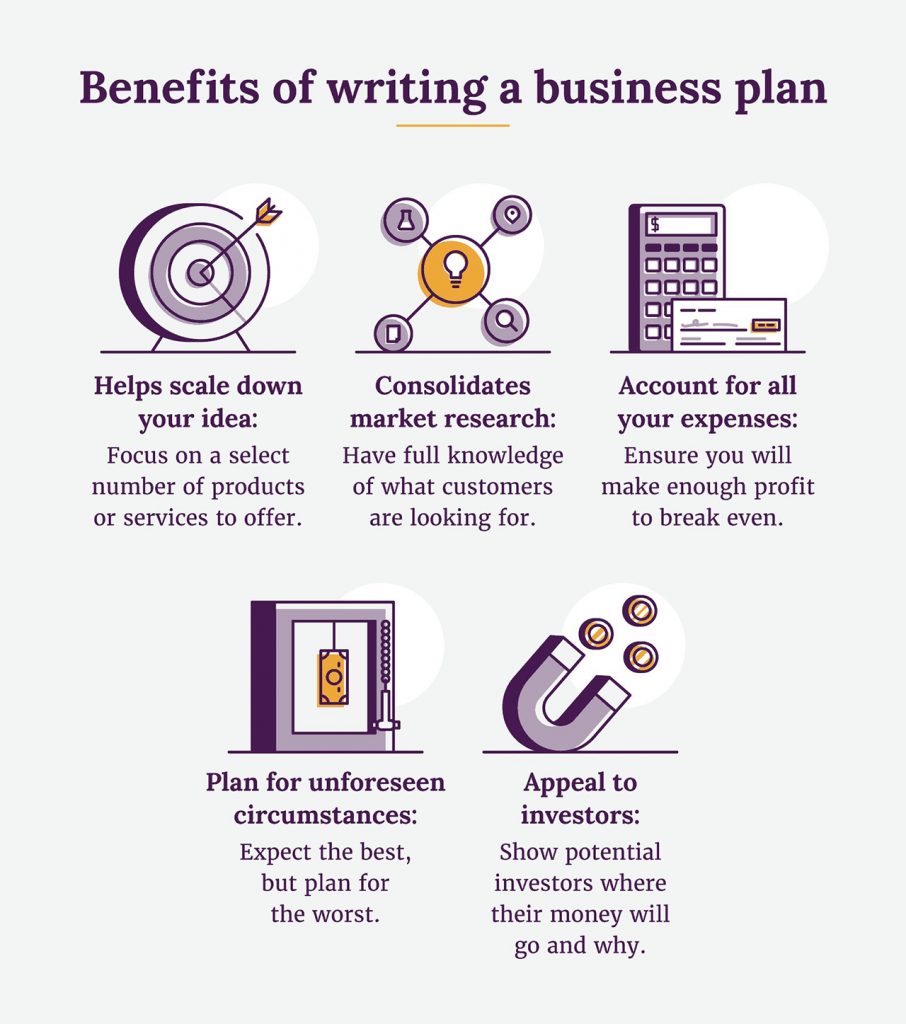
- Helps scale down your idea. The reason entrepreneurs need a business plan is to scale down their ideas to a product or service. It shows your peers and potential customers that you’re serious about your business through careful and thorough market research.
- Consolidates market research. In your business plan, you should include foundational information like your mission statement, goals, and values so that you can take advantage of all the business opportunities available to you. By having full knowledge of the market and what customers are looking for, you can advertise your mission accordingly.
- Account for all your expenses. The financial aspect of your business plan is critical because it determines the profit margin. There are many costs to starting a business, so ensuring your first order of business is making up for the startup costs through accounting and bookkeeping is the key to breaking even.
- Plan for unforeseen circumstances. Making a detailed plan will ensure that you have a strategy should unforeseen events occur. Being an entrepreneur requires you to plan for asset management and even an exit strategy.
- Appeals to investors. Last but definitely not least, writing a business plan shows investors that their money would go to good use should they choose to invest. Ensure that potential investors are confident in your business by having a concrete financial and accounting plan and a solid understanding of the legal structure of your business.
Benefits of a business plan template
Instead of writing your business plan from scratch, there are plenty of business plan templates available for different types of startups. By using a template, you’re able to cover all your bases and mimic the format of what businesses in your industry are already doing.
Templates also help make sure you don’t miss any important details in each section and account for every aspect of business planning. It leaves much less guesswork when it comes to creating a thorough business plan for your company. Some additional benefits of using a business plan template include:
- Reduce the likelihood of writer’s block. It’s easy to get writer’s block when writing a long business plan with pages in the double digits. Templates offer a comprehensive layout so you have a guided plan you can follow.
- Choose from a wide range of templates. There are hundreds of thousands of sample business plans available on the internet, so finding one that fits your business model is easier now more than ever. Whether you’re starting a small side business or a huge corporation, there's something for you.
- Select a template at no cost to you. Unless there's a specific business plan you'd like to purchase, you can download most business plan templates for free. It takes the guesswork out of what to include in your business plan since it’s already laid out for you, free of cost.
Elements of a business plan
Once you have a template, it may seem overwhelming. You may not know what to fill out in each section or if certain sections even apply to you. We’ve detailed each section of a business plan below.
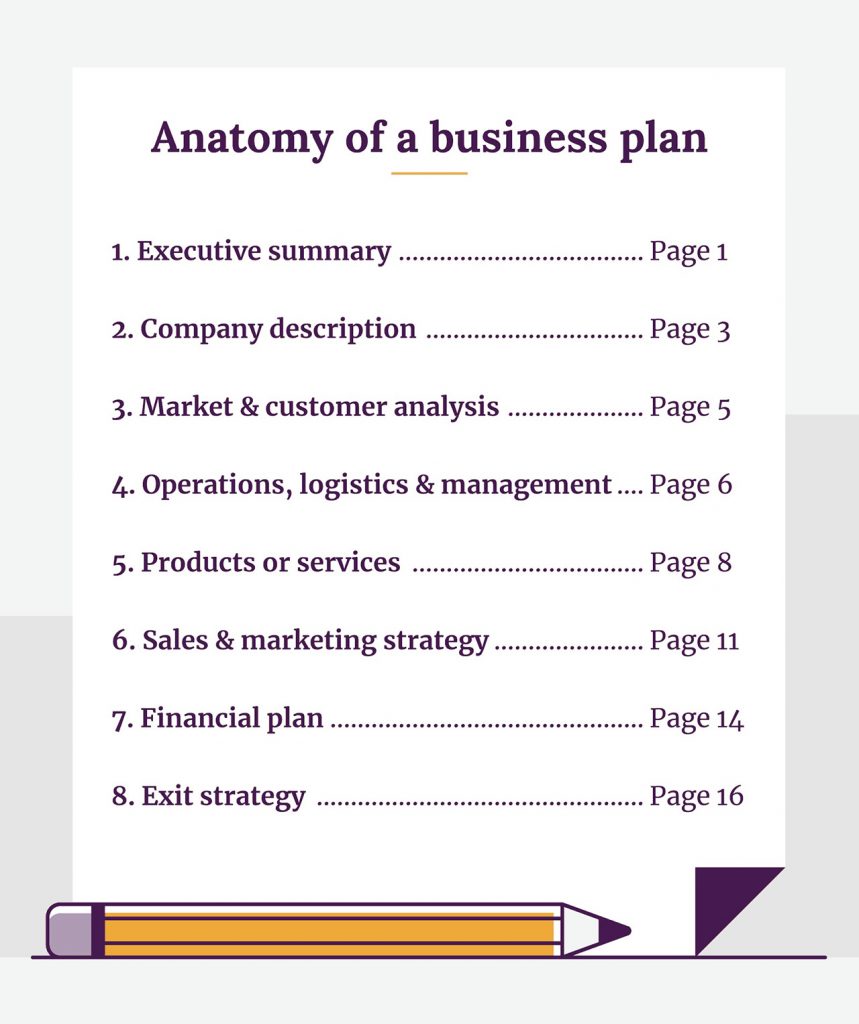
1. Executive summary
The first component of your business plan, following the title page and table of contents, is the executive summary. It’s usually written last, even though it’s what introduces your business and the plan for it. This overview of your business should be engaging like the first page of a book. You must capture the reader’s attention to get them to keep reading.
The information in your executive summary includes your mission, business size, location, management, ownership, and your product or service. You’ll also want to give the reader a sneak peek of the target market and how you'll meet the market’s needs.
In addition, you should also include what competition you’re up against, how you'll obtain market share, and financial requirements and projections.
2. Company description
Similar to the executive summary, the company description will also introduce your business. First and foremost, you should detail the industry you’re entering and how you'll distinguish yourself from competitors. Introduce your business, how it will fit into different market areas, and how your products or services will satisfy customer needs and wants.
3. Industry analysis
Also known as the market analysis, the industry analysis takes an in-depth look at the market you’re entering, how competitive it is, and how this justifies your expenditures.
This is where you can show investors you’ve done your research and that you’re entering a growing market with a definitive target audience. It would help if you also showed a demand for the product or service you’re offering.
A SWOT (Strengths, Weaknesses, Opportunities, Threats) analysis is the perfect way to incorporate all these factors in an organized manner. Make sure to include the market size, sales volume, and value, as well as barriers to entry if there are any.
4. Competitive analysis
The competitive analysis builds on the industry analysis by identifying specific competitors to your business. You should cover three things in this section: direct competitors, indirect competitors, and your competitive advantage.
Direct competitors are the companies that solve the same customer problem that you do with a similar solution. Once you’ve identified these companies, make sure to include their name, overview, products or services, pricing, and market segmentation. It will also help to do a SWOT analysis of each competitor.
Indirect competitors solve the same customer problem with a different solution. You’ll want to include similar points as you would for direct competitors.
After your competitors have been identified, you’ll want to show how you have a competitive advantage — what differentiates you from the competition, and what findings can you draw from your competitors’ weaknesses? Knowing you have a strategy to outcompete your competitors will show investors that you have a detailed game plan.
5. Customer analysis

In this section, you'll focus on your target market customers and what their needs are. Two things you’ll need to know to complete this section are who your target customers are and what they want. Based on this, you’ll develop how your company solves the customer’s problem or satisfies their needs.
An excellent way to organize this information is an environmental analysis with market segmentation. There are several demographic segmentation of the target market, such as age, income, gender, location, value, and many other characteristics you can use to make your customer profile.
6. Marketing plan
One of the most important parts of your business plan is your marketing strategy. This section details your products or services, pricing, and promotion.
You should list all your key products or services, descriptions, and pricing in the products or services subcategory. You should discuss how you plan to attract new customers and what marketing channels (email marketing, content marketing, etc.) you'll utilize for your promotion campaign.
7. Logistics and operations plan
The operations plan for your business is essential as it details the day-to-day processes of your company and the key milestones used to gauge your company’s growth.
Key operational processes are your company's daily actions to serve customers like marketing, product development, customer service, manufacturing, and administration.
Once those are in place, you can establish milestones for your company’s growth, such as your launch date, revenue milestones, or when you plan to introduce new products or services.
8. Ownership and management plan
This part of the business plan answers the “who” question: Who will own and maintain your business values? This section should detail your legal structure (limited liability company, sole proprietorship, etc.), your management, and your staff requirements.
As a result, you ensure that you have their positions, roles, and payroll in order when it comes time to hire employees.
9. Business financial plan
The financial aspect of your business plan is the most important part for investors or lenders because it demonstrates whether or not your business will be profitable and grow.
You'll want to include 4 things in your business financial plan:
- Revenue model
- Financial highlights,
- Funding requirements
- Exit strategy
The revenue model will show how your company will profit, e.g., through product sales or a monthly subscription fee from customers. The financial highlights will include a financial forecast with a five-year projected income statement, balance sheet, and cash flow statements. You’ll also want to include a breakeven analysis to show investors how much you need to make a profit after startup costs are paid off.
The funding requirements will detail where the money lent or invested will go in your business. How much will go to product development? Marketing? Staffing? Showing lenders where their money is going will give them more confidence in you.
Finally, you’ll want to plan for an exit strategy if you’re looking to seek equity capital and eventually sell your business. It helps to do some market research into how companies in the same industry have exited and for how much. Investors want to know how much they will get back should you decide to cash out. Even if you don’t plan to sell your business, you never know what will happen, so preparing an exit strategy is a proactive way to plan.
10. Appendix
This final section of the business plan can present any detailed information that supports the preceding sections of the plan. It should also include the full financial statements from the financial plan section. Some points to include in this section are the credit histories for the business owners, diagrams and market research, mortgage documents, references, and links to your business’s website.
Five downloadable business plan templates
Now that you’re familiar with the different sections in every business plan template, we’ll introduce you to a range of free, downloadable business plan templates you can utilize based on your needs. Whether you’re starting an online business at home or a local small business, below are business plans and examples for several types of businesses.
1. Simple business plan template

Starting with a simple business plan template is an excellent way to begin the blueprint for your business. It includes all the sections listed above as well as what to include in each section. This business plan can be used to secure funding or to have on hand should you ever need it.
2. Startup business plan template

Startups are a unique type of business typically founded by one or more entrepreneurs. Since their budget is usually quite small, the first order of business is getting investors and funding for their product idea or service. This makes concrete and comprehensive business plan a must-have.
This startup business plan template has all the necessary components of a business plan that would appeal to investors, with a detailed financial plan section. This is crucial to selling your idea.
3. Creative business plan template
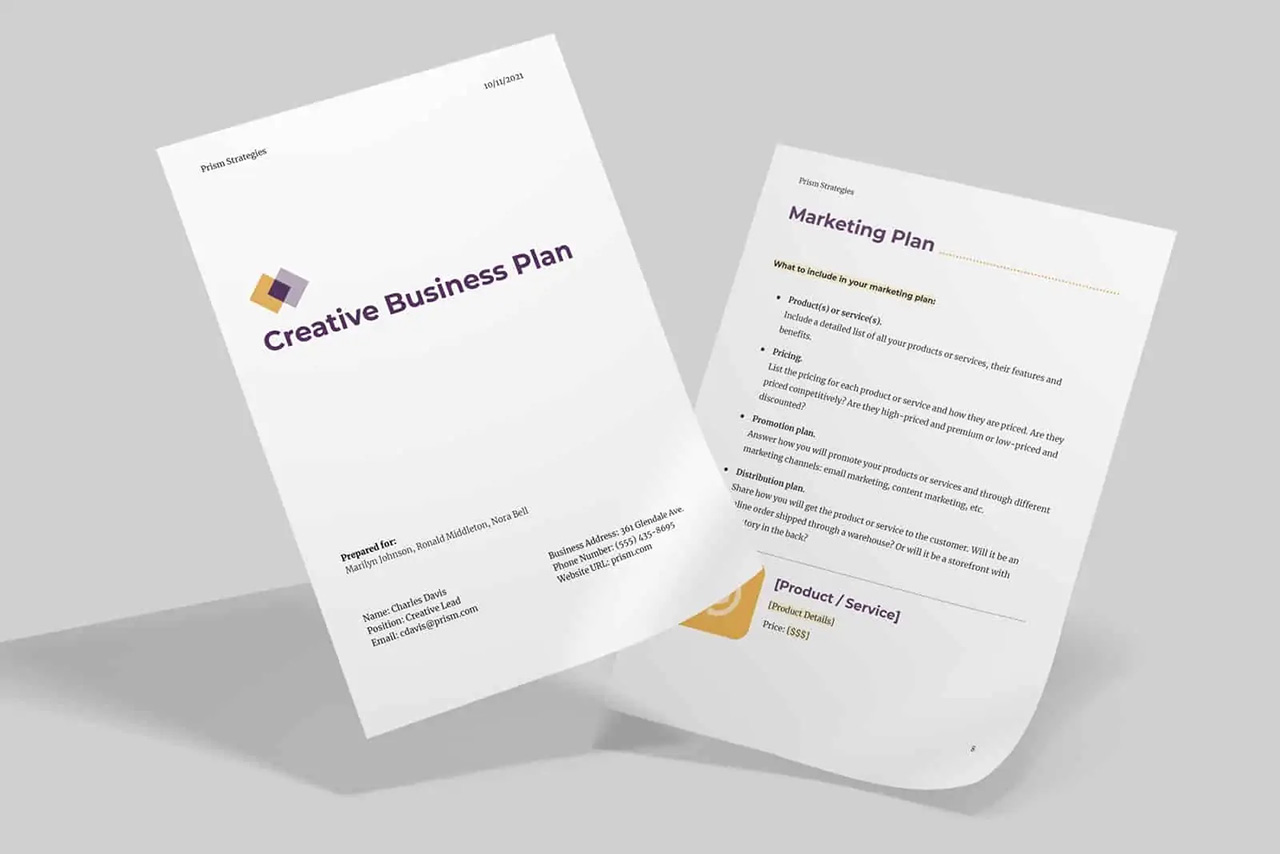
Creative industries like graphic design, marketing, web design, and the fine arts allow for more artistic expression in their business plan. Illustrations and visual elements complement the information and help make your business come to life.
This creative business plan template implements design principles while also presenting the information needed to start this type of business in an aesthetically pleasing manner.
4. Professional business plan template
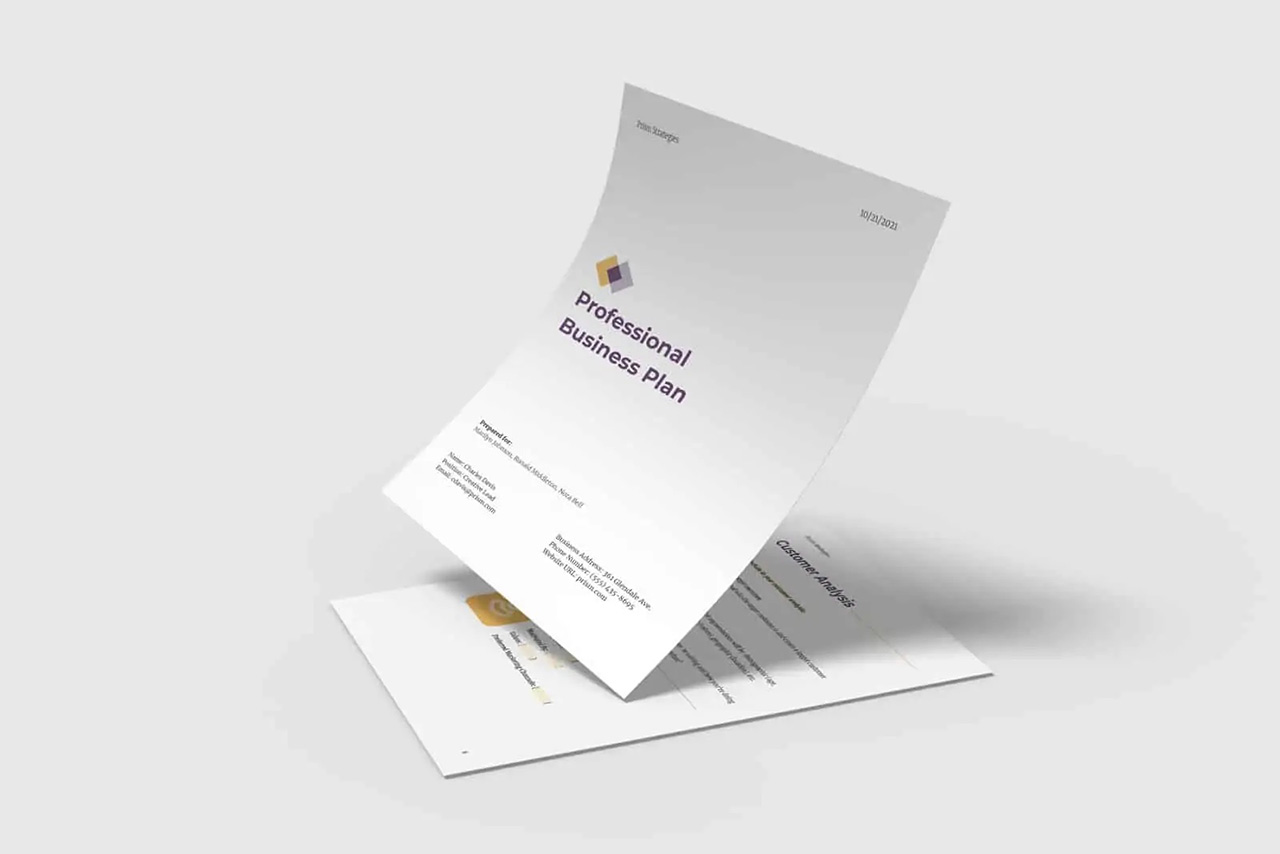
Small businesses like private practice law firms and health care startups often need funding from investors, and with that, they need a professional business plan to show lenders they plan for the future.
This professional business plan template covers everything you need to include for investors to trust you with this entrepreneurial endeavor.
5. Financial plan template
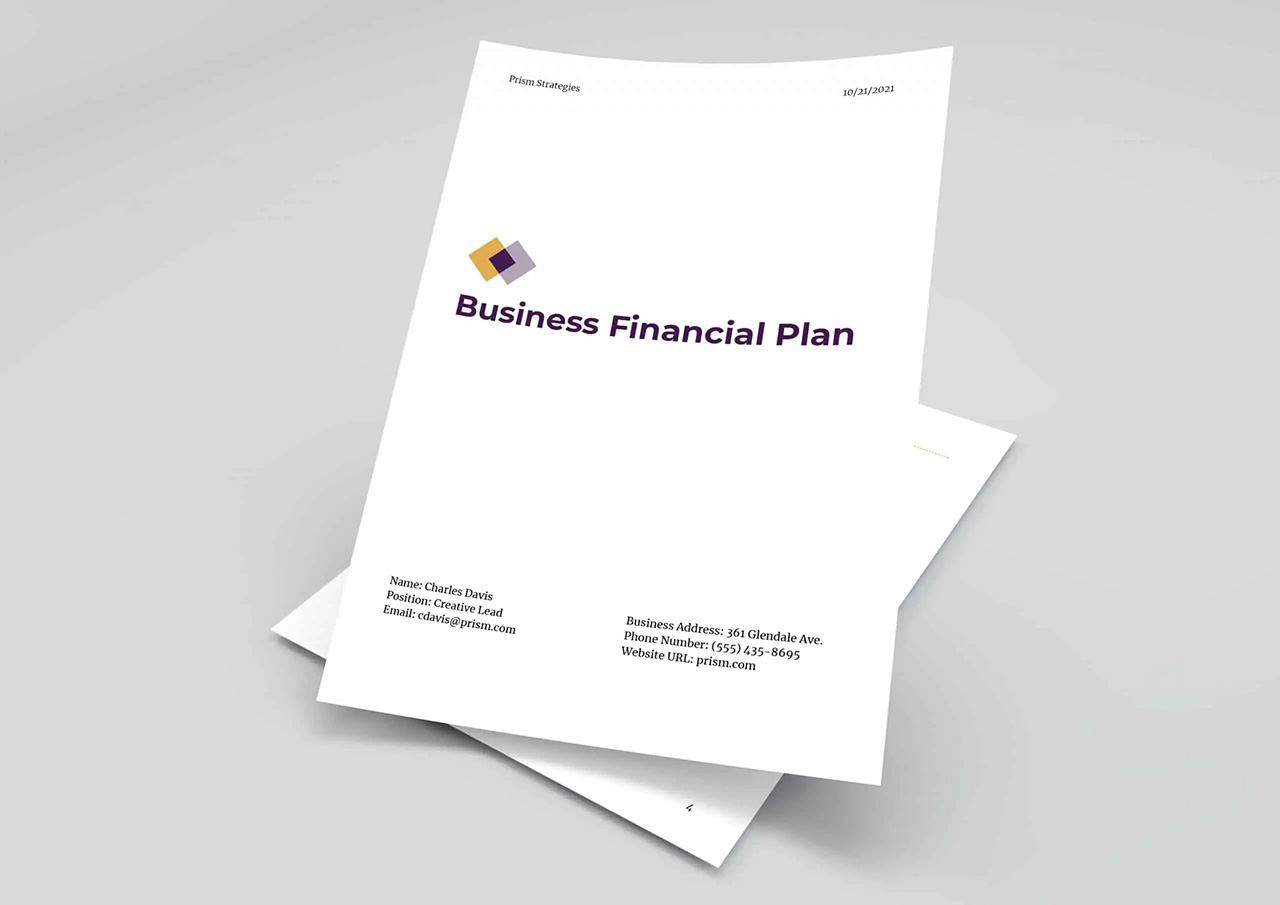
The financial plan is arguably one of the most important sections of a business plan since it outlines the financial projections for the company. Without income statements, balance sheets, or a breakeven analysis, it won't be easy to get investors to be sold on your idea. This financial plan template gives you a breakdown of the different sections in a financial plan and what to include.
Business plan examples to inspire you
While the templates above are thorough explanations of what to write in each section of your business plan, examples of business plans can serve as inspiration for your own business. Below, we’ve found some inspiring business plan examples from a variety of industries.
1. Retail e-commerce business plan example
This e-commerce business plan for a cookware sales company combines a clean design with informative graphics. Not only do they explain their marketing plan in detail, but they also include funding requirements and financial projections for potential investors. Although this business plan is fictional, it includes all the sections you need for your real business.
2. Consulting business plan example
Starting your own consulting business is a path many professionals take after working in the industry full-time. This business model allows you to take on projects based on your personal preference, so this consulting business plan example condenses all the important business plan elements onto one page.
3. Event planning business plan example
If you have a knack for putting together spectacular events, it might be in your best interest to start an event planning business. This event planning business plan example includes special sections like a party pack you can offer and detailed startup expenses, so you feel prepared to become a professional event planner.
4. Food and beverage business plan example
There can never be enough restaurants out there, so starting your own food and beverage company is an excellent way to break into entrepreneurship. This example bakery business plan explains why there's a need for their product and how they will address that need.
5. Technology business plan example
There are all kinds of technology startups, given the complex nature of the industry. Whether your specialty is app development or web design, this technology business plan has everything you need to give investors confidence in your idea.
6. Health and wellness business plan example
As people grow increasingly passionate about achieving healthy lifestyles, now is as good a time as any to start a health and wellness business. This customizable MindBody business plan incorporates the necessary aspects of a wellness business while allowing for creative flexibility.
Wrapping up: Business plan summary
Although planning isn’t for everyone, it's a necessary step for any entrepreneur. A comprehensive and detailed business plan is the first step to making your entrepreneurial ventures a success.
Once you have a road map for where you want your business to go and what you want to achieve, you can hire a team of experts to help you make that dream a reality.
Sources: SBA | Purdue | Cornerstone










